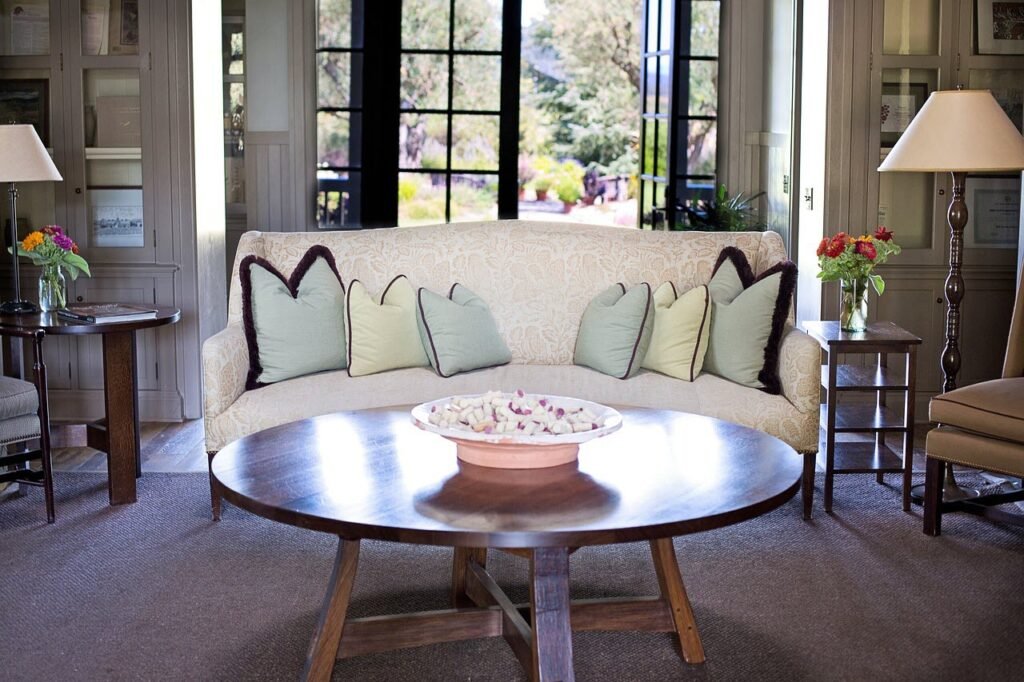Layering in Home Staging & Interior Design:
Combining various elements like texturesMateriality in Home Staging & Interior Design: The selection and combination of materials used in a space, like wood, metal, glass, fabric, and stone. In staging and design, it influences the overall aesthetic, texture, and tactile experience, impacting the mood and functionality of the space. T... More, patterns, and colors in a space to add depth, visual interest"Focal Point" in Home Staging & Interior Design: A visual element that draws attention and sets the tone for a space, like a fireplace, artwork, or architectural feature. Effective staging uses focal points strategically. The Importance of Focal Point in Home Staging - Why It's Something to Cons... More, and a sense of coziness. Layering is a key technique in creating inviting and stylish spaces.

The Importance of Layering in Home Staging – Why it’s Something to Consider
Layering in home staging is the art of using various textiles, colors, and accessories"Accessories & Antiques" in Home Staging & Interior Design: Decorative elements like vases, sculptures, throws, or vintage finds that personalize a space, add texture and pops of color, and tell a story about the homeowner's style. The Importance of Accessories & Antiques In Home Staging... More to create depth and interest in a space. It involves combining different elements like rugs, throw pillowsThrow Pillows in Home Staging & Interior Design: A decorative pillow placed on a sofa, bed, or chair, adding color, pattern, and texture. The Importance of Throw Pillows in Home Staging - Why it's Something to Consider Throw Pillows are an essential element in home staging as they can add color,... More, curtains, and artwork to add warmth and personalityStyle in Home Staging & Interior Design: The overall aesthetic or design language chosen for a space, influencing furniture selection, décor, color palette, and textures. The Importance of Style in Home Staging - Why it's Something to Consider The Style chosen in home staging sets the overall t... More to a room. Effective layering can make a space feel"Aesthetic" in Home Staging & Interior Design: The overall feeling or vibe of a space, encompassing the chosen style, color palette, textures, and furniture, and evoking a specific mood or impression. The Importance of Aesthetic In Home Staging - Why It's Something to Consider Aesthetic, encompa... More more inviting and lived-in, which is essential in creating an emotional connectionStaging Psychology in Home Staging & Interior Design: Understanding the psychological impact of space on potential buyers and utilizing staging techniques to evoke positive emotions. The Importance of Staging Psychology in Home Staging - Why it's Something to Consider Staging Psychology involves... More with potential buyers.
When considering layering in home staging, it’s important to strike a balanceVisual Weight in Home Staging & Interior Design: The perceived heaviness or lightness of objects and elements within a space, influencing balance and visual interest. The Importance of Visual Weight in Home Staging - Why it's Something to Consider Visual Weight in home staging refers to the perc... More so that the space doesn’t feel cluttered or overwhelming. The layers should complement each other and the overall design of the room, enhancing its appeal without dominating it. Layering is a subtle art that, when done well, can significantly elevate the attractiveness"Appeal" in Home Staging & Interior Design: The overall attractiveness and desirability of a property to potential buyers, influenced by factors like curb appeal, layout, functionality, and staging. The Importance of Appeal In Home Staging - Why It's Something to Consider Appeal, in the context ... More of a property.
Tips and Best Practices when Utilizing Layering in Home Staging
Layering in home staging involves adding depth and interest through textures, colors, and decor. Best practices include:
TextureTexture in Home Staging & Interior Design: The surface quality of materials used in a space, adding visual interest and tactile elements. The Importance of Texture in Home Staging - Why it's Something to Consider Texture adds depth and interest to a space, making it an important element in home ... More Variation: Mix and match different textures, such as smooth, plush, or rough, to create visual interest and depth.
Color Coordination: Layer colors in a way that complements the room’s overall color scheme"Color Palettes" in Home Staging & Interior Design: The range of colors chosen for a space, including walls, furniture, fabrics, and décor, setting the overall mood and influencing the perception of size, light, and warmth. The Importance of a Color Palette In Home Staging - Why It's Something ... More. Use accent colors for pops of interest.
Decorative Elements: Layer decorative elements like throw pillows, rugs, and curtains to add warmth and personality.
Balance"Balance" in Home Staging & Interior Design: A sense of visual equilibrium and harmony achieved through arrangement, scale, color distribution, or symmetry, creating a pleasing and comfortable composition. The Importance of Balance In Home Staging - Why It's Something to Consider Balance is a ke... More and HarmonySymmetry and Balance in Home Staging & Interior Design: Creating a sense of order and visual harmony in a space through balanced furniture placement and repetition of design elements. The Importance of Symmetry and Balance in Home Staging - Why it's Something to Consider Symmetry and Balance are... More: Ensure that the layers work harmoniously together and do not overwhelm the space.
Create a Focal Point"Accent Pieces" in Home Staging & Interior Design: A striking or unique item that draws attention and becomes a focal point in a room, enhancing the overall design and setting the tone. The Importance of Accent Pieces In Home Staging - Why It's Something to Consider Accent Pieces, including stat... More: Use layering to draw attention to focal points in the room, such as a fireplace or a beautiful window.

